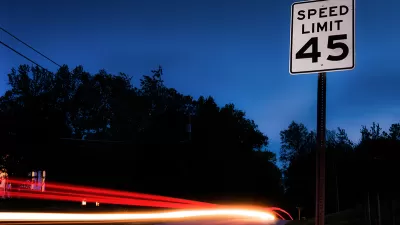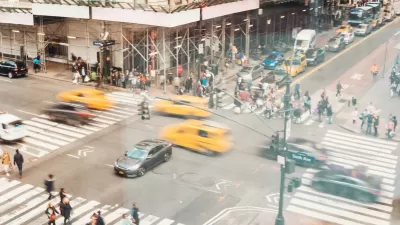Motor vehicle crashes claim over 30,000 lives per year, with related costs in the hundreds of billions. While we sometimes view that frightening statistic as inevitable, there are reasons to reexamine speed limits and how we set them.

In this article, Anna Maria Barry-Jester asks the question: where do speed limits come from? "Given the social and economic toll of speeding, one might assume that we set speed limits with careful calculations aimed at maximizing safety." However, she continues, "in most places, speed limits are largely determined by the speed most people feel safe traveling."
This average comfortable speed sits at a hypothetical 85th percentile: given the road, 85% of drivers will cruise below it and 15 percent will speed above it. But road engineers know this, and build margins of "safety" into new roads: "[the 85th percentile is] used to design a road to meet that speed at a minimum, with a factor of safety allowing for faster travel."
The article discusses a historical shift from keeping roads safe from cars, to keeping them safe for cars. "City speed limits were set below 20 mph until automakers and industry groups realized that such low limits were going to hurt sales. To change public opinion, campaigns were started to criminalize pedestrians in the road (jaywalking) and to shift the blame for accidents from cars to 'reckless drivers.'"
Nowadays, people are less willing to accept the auto-centric status quo, at least in cities. Recent efforts like New York's Vision Zero plan mark departures from our "culture of acceptance" around traffic fatalities.
FULL STORY: Why The Rules Of The Road Aren’t Enough To Prevent People From Dying

Alabama: Trump Terminates Settlements for Black Communities Harmed By Raw Sewage
Trump deemed the landmark civil rights agreement “illegal DEI and environmental justice policy.”

Study: Maui’s Plan to Convert Vacation Rentals to Long-Term Housing Could Cause Nearly $1 Billion Economic Loss
The plan would reduce visitor accommodation by 25% resulting in 1,900 jobs lost.

Planetizen Federal Action Tracker
A weekly monitor of how Trump’s orders and actions are impacting planners and planning in America.

Wind Energy on the Rise Despite Federal Policy Reversal
The Trump administration is revoking federal support for renewable energy, but demand for new projects continues unabated.

Passengers Flock to Caltrain After Electrification
The new electric trains are running faster and more reliably, leading to strong ridership growth on the Bay Area rail system.

Texas Churches Rally Behind ‘Yes in God’s Back Yard’ Legislation
Religious leaders want the state to reduce zoning regulations to streamline leasing church-owned land to housing developers.
Urban Design for Planners 1: Software Tools
This six-course series explores essential urban design concepts using open source software and equips planners with the tools they need to participate fully in the urban design process.
Planning for Universal Design
Learn the tools for implementing Universal Design in planning regulations.
Caltrans
Smith Gee Studio
Institute for Housing and Urban Development Studies (IHS)
City of Grandview
Harvard GSD Executive Education
Toledo-Lucas County Plan Commissions
Salt Lake City
NYU Wagner Graduate School of Public Service





























